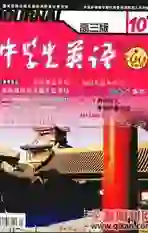如何利用上下文进行完形填空信息推断
2008-11-19许佩芬
许佩芬
众所周知,完形填空是考查考生利用上下文语境逻辑推断空档处未知信息的试题,因此利用正向推断法、逆向推断法和正向逆向联合推断法可以巧妙解答完形填空题。本文结合2008年高考英语试题全国卷II完形填空题介绍如何利用上下文进行完形填空信息推断。
From the time each of my children started school, I packed their lunches. And in each lunch, I_21_a note. Often written on a napkin(餐巾), it might be a thank-you for a
_22_moment, a reminder of something we were happily expecting, or a bit of_23_for the coming test or sporting event.
In early grade school they_24_their notes. But as children grow older, they become self-conscious(有自我意识的), and_25_
he reached high school, my older son, Marc, informed me he no longer_26_my daily notes. Telling him that he no longer needed to
_27_them but I still needed to write them, I_28_until the day he graduated.
Six years after high school graduation, Marc called and asked if he could move
_29_for a couple of months. He had spent those years well, graduating from college,
_30_two internships (实习) in Washington D.C., and_31_, becoming a technical assistant in Sacramento._32_short vacation visits, however, he had lived away from home. With his younger sister leaving for college, I was_33_happy to have Marc back. Since I was_34_making lunch for his younger brother, I_35_one for Marc, too. Imagine my_36_when I got a call from my 24-year-old son,_37_his lunch.
“Did I do something_38_? Dont you love me_39_, Mom?” were just a few of the questions he threw at me as I_40_asked him what was wrong.
“My note, Mom,” he answered. “Wheres my note?”
21. A. carried B. found
C. included D. held
22. A. difficult B. special
C. comfortable D. separate
23. A. congratulation B. improvement
C. explanation D. encouragement
24. A. loved B. answered
C. wrote D. examined
25. A. lately B. by the way
C. by the time_ D. gradually
26. A. received B. understood
C. enjoyed D. collected
27. A. copy B. read
C. take D. send
28. A. held up B. gave up
C. followed D. continued
29. A. out B. home
C. to college D. to Sacramento
30. A. organizing B. planning
C. comparing D. completing
31. A. hopefully B. finally
C. particularly D. certainly
32. A. Because of B. Instead of
C. Except for D. As for
33. A. especially B. immediately
C. equally D. generally
34. A. once B. again
C. still D. even
35. A. packed B. fetched
C. bought D. filled
36. A. fear B. surprise
C. anger D. disappointment
37. A. waiting for B. worrying about
C. caring for D. asking about
38. A. wrong B. funny
C. strange D. smart
39. A. any more B. enough
C. once more D. better
40. A. interestingly B. bitterly
C. politely D. laughingly
一、利用正向推断法推断空档处未知信息
正向推断法要求考生利用上文已知信息推断下文未知信息,当然这儿所指的上文已知信息并不仅仅是靠近空档的上文已知信息,也包括离空档较远的甚至文章开头的上文已知信息。考生应认真阅读分析空档处上文内容,弄清事实与细节,并思考其如何向下文发展,从而推断下文未知信息。例如:
第22空应填special,因为借助上文a thank-you可知,需要向对方表示感谢的时刻一定是特殊时刻。第26空应填enjoyed,因为由上文第24空的loved和其后的But可以推出Marc不再喜欢母亲每天写条子给他。第31空应填finally,因为上文had spent those years well, graduating from college, completing two internships都是Marc求学的过程,因此该空应填finally表示求学的结果。第33空应填especially,因为由上文With his younger sister leaving for college可知,作者内心比较寂寞,因此儿子回家住特别让她感到高兴。第35空应填packed,因为由首句中的packed their lunches可知,作者给子女准备午餐是一件很自然的事。第40空应填laughingly,因为上文Marc所问内容确实让人感到好笑。
二、利用逆向推断法推断空档处未知信息
逆向推断法要求考生利用下文已知信息反向推断上文未知信息,当然这里所说的下文已知信息不但指离空档较近的下文信息,还指离空档较远的甚至文章结尾处的下文信息。当利用上文已知信息无法正确推断下文未知信息时不能着急,应沉着冷静地阅读下文,看下文哪些事实和细节是上文未知信息的延伸和发展,并由此推断空档处的未知信息。例如:
第23空应填encouragement,因为由下文the coming test or sporting event可知,孩子们将要参加的考试和体育运动项目是需要家长给以鼓励的场合。第25空应填by the time,因为下文he reached high school体现的是informed me的时间。第27空应填read,因为由下文but I still needed to write them可以推出该空表示“读”。第28空应填continued,因为下文until the day he graduated体现了母亲在继续给Marc写条子。第29空应填home,因为由第32空后面的he had lived away from home可以推出此时Marc想回家住。第30空应填completing,因为下文two internships是Marc在工作之前必须完成的两个任务。第32空应填Instead of,因为由下文he had lived away from home可以推出该空表示“没有”。第36空应填surprise,因为由下文Marc所问作者的问题可知,作者没有料到Marc会问这些问题。第37空应填asking about,因为下文Marc讲话的内容都是一般疑问句。第38空应填wrong,因为由末句可知,作者没有给Marc写条子,因此Marc认为自己做错了什么事。第39空应填any more,因为母亲没有给自己写条子让Marc担心其不爱他了。
三、利用正向逆向联合推断法推断未知信息
不少情况下空档处未知信息既不能单独由上文正向推断而出,又不能单独由下文反向推断而出,需要考生利用其上文和下文已知信息联合推断。考生应认真阅读分析上下文,看哪些细节与事实与空档有因果关系,并由此推断空档处未知信息。例如:
第21空应填included,因为分析上文And in each lunch和下文a note之间的逻辑关系可以推出该空表示“包括”。
第24空应填loved,因为由上文作者在条上写的内容可知,条上写的是让孩子们高兴的事,因此孩子们应该喜欢这些条子。由下文But和27空后面的but I still needed to write them也可以推出该空表示“喜欢”。
第34空应填still,因为由首句可以推出以前作者就在给Marc的弟弟准备午餐,由下文可知作者此时也在给他准备午餐,因此该空表示“仍然”。
